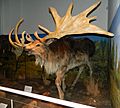Deer of Great Britain facts for kids
There are six main types of deer that live wild in Great Britain. These include the Scottish red deer, roe deer, fallow deer, sika deer, Reeves's muntjac, and the Chinese water deer.
Some of these deer, like the Scottish red deer and roe deer, are native. This means they have lived in Britain for thousands of years, ever since the last ice age ended. Other deer, like the fallow deer, were here a long time ago but died out. They were later brought back by people, like the Romans and the Normans. The other three types of deer (sika, muntjac, and water deer) came from other countries and either escaped or were released into the wild.
Contents
Native Deer
These are the deer that have called Great Britain home for a very long time.
Scottish Red Deer
The Scottish red deer is the largest land mammal in Great Britain. They are majestic animals, known for their impressive antlers on the males. You'll mostly find them in the wild, open landscapes of the Scottish Highlands, but they also live in parts of England. They are a subspecies of the larger red deer found across Europe and Asia.
Roe Deer
Roe deer are much smaller than red deer. They are very common and can be found in woodlands, forests, and even farmlands across most of Great Britain. They are shy and often seen alone or in small family groups. Roe deer have short, reddish-brown coats in summer that turn greyish in winter.
Deer from Other Countries
These deer were originally from other parts of the world but now live in the wild in Great Britain.
Fallow Deer
Fallow deer are quite distinctive with their spotted coats, especially in summer. They were first brought to Britain by the Romans and then again by the Normans, making them a very old introduced species. Males have broad, flattened antlers. They often live in herds and are common in parks and woodlands.
Sika Deer
Sika deer originally came from East Asia. They look a bit like smaller red deer and can be quite noisy, making loud whistling calls. They are found in various parts of Great Britain, often in forests and heathlands. There are several different types of sika deer that have been introduced.
Reeves's Muntjac
The Reeves's muntjac is a very small deer, sometimes called the "barking deer" because of the loud, dog-like bark they make when alarmed. They came from China and are now widespread across England and Wales. They are quite secretive and prefer dense undergrowth in woodlands and gardens.
Chinese Water Deer
The Chinese water deer is one of the most unique deer in Britain. Unlike other deer, the males do not grow antlers. Instead, they have long, curved tusks that stick out from their mouths, giving them a "vampire deer" look! They are excellent swimmers and prefer marshy areas and wetlands, mostly found in parts of eastern England.
Deer That Came Back
These deer once lived in Great Britain but died out. Some have been brought back, usually to special reserves.
Eurasian Elk (Moose)
The Eurasian elk, also known as the moose, is the largest deer species in the world. They are huge animals with massive, broad antlers. While they once lived wild in Britain, they died out long ago. Today, you can find them on a few private reserves, but they are not living wild across the country.
Reindeer
Reindeer are famous for living in cold, snowy places and are often associated with Christmas! They also once lived in Great Britain but became extinct here. Now, there are small herds of reindeer on private reserves, particularly in Scotland, where they have been reintroduced.
Deer That Are Gone
These deer used to live in Great Britain but are now extinct, meaning they no longer exist anywhere in the world.
Irish Elk
The Irish elk was a giant deer species that lived during the last Ice Age. Despite its name, it wasn't just found in Ireland; its fossils have been found across Europe, Asia, and North Africa, including Great Britain. Males had enormous antlers, the largest of any known deer, spanning up to 3.6 meters (12 feet) wide! They died out around 7,700 years ago.
Images for kids
-
Irish elk (extinct)










